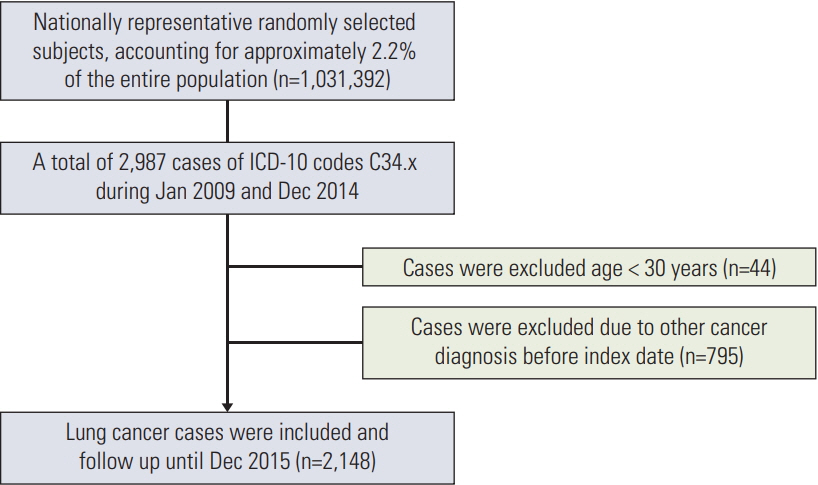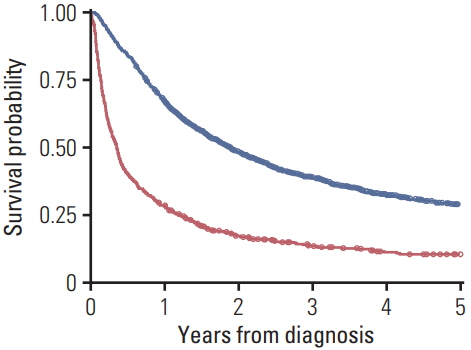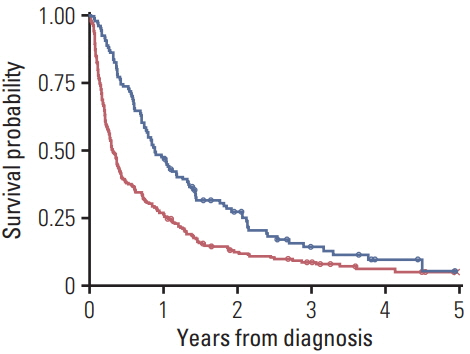Cancer Res Treat.
2019 Jul;51(3):1241-1248. 10.4143/crt.2018.513.
Higher Age Puts Lung Cancer Patients at Risk for Not Receiving Anti-cancer Treatment
- Affiliations
-
- 1Department of Internal Medicine, Keimyung University Dongsan Medical Center, Daegu, Korea. wichoi@dsmc.or.kr
- 2Department of Statistics, Kyungpook National University, Daegu, Korea.
- 3Department of Occupational and Environmental Medicine, Sungso Hospital, Andong, Korea.
- KMID: 2454315
- DOI: http://doi.org/10.4143/crt.2018.513
Abstract
- PURPOSE
We aimed to determine the demographic and epidemiologic variables that are associated with no treatment in lung cancer patients.
MATERIALS AND METHODS
Patient data were collected from the Korean National Health Insurance Database. The lung cancer group included patients with an initial diagnosis of lung cancer between January 2009 and December 2014. Treated cases were defined as those that underwent surgery, radiation, or chemotherapy until death, after the diagnosis of lung cancer. Risk of no treatment was calculated by multiple logistic regression analysis.
RESULTS
Among the 2,148 new cases of lung cancer from 2009 to 2104, 612 (28.4%) were not treated. Risk of no treatment was higher in the following patients: patients in their 60s (odds ratio [OR], 1.18; 95% confidence interval [CI], 0.75 to 1.84), 70s (OR, 3.64; 95% CI, 2.41 to 5.50), and >80 years old (OR, 16.55; 95% CI, 10.53 to 25.03) than those in their 50s; patients with previous myocardial infarction (OR, 2.07; 95% CI, 1.01 to 4.25) or chronic kidney disease (OR, 2.88; 95% CI, 1.57 to 5.30); and patients diagnosed at a non-referral hospital (OR, 1.40; 95% CI, 1.01 to 1.92) or primary care provider (OR, 1.81; 95% CI, 1.43 to 2.29) compared with referral hospital. Low-income patients receiving Medicaid were 1.75 times (95% CI, 1.14 to 2.68) more likely to forgo treatment than high-income patients (upper 20%). Risk was not associated with sex or the year in which the lung cancer was diagnosed.
CONCLUSION
Age predominantly determines whether patients with lung cancer undergo anti-cancer treatment.
Keyword
MeSH Terms
Figure
Reference
-
References
1. Thun MJ, Henley SJ, Travis WD. Lung cancer. In : Thun MJ, Linet MS, Cerhan JR, Haiman CA, Schottenfeld D, editors. Cancer epidemiology and prevention. New York: Oxford University Press;2018. p. 519–41.2. Jung KW, Won YJ, Kong HJ, Lee ES; Community of Population-Based Regional Cancer Registries. Cancer statistics in Korea: incidence, mortality, survival, and prevalence in 2015. Cancer Res Treat. 2018; 50:303–16.
Article3. National Cancer Institute Surveillance Epidemiology, and End Results Program. SEER Cancer Stat Facts: Lung and Bronchus Cancer [Internet]. Bethesda, MD: National Cancer Institute;c2018. [cited 2018 Aug 6]. Available from: http://seer.cancer.gov/statfacts/html/lungb.html.4. Park JY, Jang SH. Epidemiology of lung cancer in Korea: recent trends. Tuberc Respir Dis. 2016; 79:58–69.
Article5. Small AC, Tsao CK, Moshier EL, Gartrell BA, Wisnivesky JP, Godbold JH, et al. Prevalence and characteristics of patients with metastatic cancer who receive no anticancer therapy. Cancer. 2012; 118:5947–54.
Article6. David EA, Daly ME, Li CS, Chiu CL, Cooke DT, Brown LM, et al. Increasing rates of no treatment in advanced-stage nonsmall cell lung cancer patients: a propensity-matched analysis. J Thorac Oncol. 2017; 12:437–45.7. Huang HL, Kung PT, Chiu CF, Wang YH, Tsai WC. Factors associated with lung cancer patients refusing treatment and their survival: a national cohort study under a universal health insurance in Taiwan. PLoS One. 2014; 9:e101731.
Article8. Mok TS, Wu YL, Thongprasert S, Yang CH, Chu DT, Saijo N, et al. Gefitinib or carboplatin-paclitaxel in pulmonary adenocarcinoma. N Engl J Med. 2009; 361:947–57.
Article9. Kwak EL, Bang YJ, Camidge DR, Shaw AT, Solomon B, Maki RG, et al. Anaplastic lymphoma kinase inhibition in nonsmall-cell lung cancer. N Engl J Med. 2010; 363:1693–703.10. Borghaei H, Paz-Ares L, Horn L, Spigel DR, Steins M, Ready NE, et al. Nivolumab versus docetaxel in advanced nonsquamous non-small-cell lung cancer. N Engl J Med. 2015; 373:1627–39.
Article11. Garon EB, Rizvi NA, Hui R, Leighl N, Balmanoukian AS, Eder JP, et al. Pembrolizumab for the treatment of non-small-cell lung cancer. N Engl J Med. 2015; 372:2018–28.
Article12. Janne PA, Yang JC, Kim DW, Planchard D, Ohe Y, Ramalingam SS, et al. AZD9291 in EGFR inhibitor-resistant nonsmall-cell lung cancer. N Engl J Med. 2015; 372:1689–99.
Article13. Temel JS, Greer JA, Muzikansky A, Gallagher ER, Admane S, Jackson VA, et al. Early palliative care for patients with metastatic non-small-cell lung cancer. N Engl J Med. 2010; 363:733–42.
Article14. Wang S, Wong ML, Hamilton N, Davoren JB, Jahan TM, Walter LC. Impact of age and comorbidity on non-small-cell lung cancer treatment in older veterans. J Clin Oncol. 2012; 30:1447–55.
Article15. Korean Statistical Information Service. Cancer incidence in Korea [Internet]. Daejeon: Statistics Korea;2016. [cited 2018 Nov 3]. Available from: http://kosis.kr/statHtml/statHtml.do?orgId=117&tblId=DT_117N_A0024&conn_path=I3.16. Suh WN, Kong KA, Han Y, Kim SJ, Lee SH, Ryu YJ, et al. Risk factors associated with treatment refusal in lung cancer. Thorac Cancer. 2017; 8:443–50.
Article17. World Health Organization. Life expectancy increased by 5 years since 2000, but health inequalities persist [Internet]. Geneva: World Health Organization;c2016. [cited 2018 Aug 7]. Available from: http://www.who.int/en/news-room/detail/19-05-2016-life-expectancy-increased-by-5-years-since-2000-but-health-inequalities-persist.18. Shingler SL, Bennett BM, Cramer JA, Towse A, Twelves C, Lloyd AJ. Treatment preference, adherence and outcomes in patients with cancer: literature review and development of a theoretical model. Curr Med Res Opin. 2014; 30:2329–41.
Article19. van Kleffens T, van Leeuwen E. Physicians' evaluations of patients' decisions to refuse oncological treatment. J Med Ethics. 2005; 31:131–6.
Article20. Puts MT, Monette J, Girre V, Wolfson C, Monette M, Batist G, et al. Characteristics of older newly diagnosed cancer patients refusing cancer treatments. Support Care Cancer. 2010; 18:969–74.
Article21. Lin JH, Zhang SM, Manson JE. Predicting adherence to tamoxifen for breast cancer adjuvant therapy and prevention. Cancer Prev Res (Phila). 2011; 4:1360–5.22. Min HS, Yang HK, Park K. Supporting low-income cancer patients: recommendations for the public financial aid program in the Republic of Korea. Cancer Res Treat. 2018; 50:1074–83.
Article23. Wallace SK, Lin JF, Cliby WA, Leiserowitz GS, Tergas AI, Bristow RE. Refusal of recommended chemotherapy for ovarian cancer: risk factors and outcomes; a national cancer data base study. J Natl Compr Canc Netw. 2016; 14:539–50.
Article24. Janssen-Heijnen ML, Smulders S, Lemmens VE, Smeenk FW, van Geffen HJ, Coebergh JW. Effect of comorbidity on the treatment and prognosis of elderly patients with non-small cell lung cancer. Thorax. 2004; 59:602–7.
Article25. Marshall CA, Badger TA, Curran MA, Koerner SS, Larkey LK, Weihs KL, et al. Un Abrazo Para La Familia: providing lowincome Hispanics with education and skills in coping with breast cancer and caregiving. Psychooncology. 2013; 22:470–4.
Article26. Turner D, Adams E, Boulton M, Harrison S, Khan N, Rose P, et al. Partners and close family members of long-term cancer survivors: health status, psychosocial well-being and unmet supportive care needs. Psychooncology. 2013; 22:12–9.
Article27. Goulart BH, Reyes CM, Fedorenko CR, Mummy DG, Satram-Hoang S, Koepl LM, et al. Referral and treatment patterns among patients with stages III and IV non-small-cell lung cancer. J Oncol Pract. 2013; 9:42–50.
Article28. Murgu S, Rabito R, Lasko G, Jackson C, Mino-Kenudson M, Ettinger DS, et al. Impact of a non-small cell lung cancer educational program for interdisciplinary teams. Chest. 2018; 153:876–87.
Article29. Dunn J, Garvey G, Valery PC, Ball D, Fong KM, Vinod S, et al. Barriers to lung cancer care: health professionals' perspectives. Support Care Cancer. 2017; 25:497–504.
Article30. Park S, Park IK, Kim ER, Hwang Y, Lee HJ, Kang CH, et al. Current trends of lung cancer surgery and demographic and social factors related to changes in the trends of lung cancer surgery: an analysis of the national database from 2010 to 2014. Cancer Res Treat. 2017; 49:330–7.
Article
- Full Text Links
- Actions
-
Cited
- CITED
-
- Close
- Share
- Similar articles
-
- Screening for Lung Cancer
- A Literature Review on Unmet Needs of High-Prevalence Cancer Survivors: Focus on Breast Cancer, Thyroid Cancer, Colorectal Cancer, and Lung Cancer
- Passive Smoking and Lung Cancer
- Immunohistochemical Application to the Pathologic Diagnosis of Lung Cancer
- Anti-Cancer Therapy of Advanced Lung Cancer in Elderly Patients




